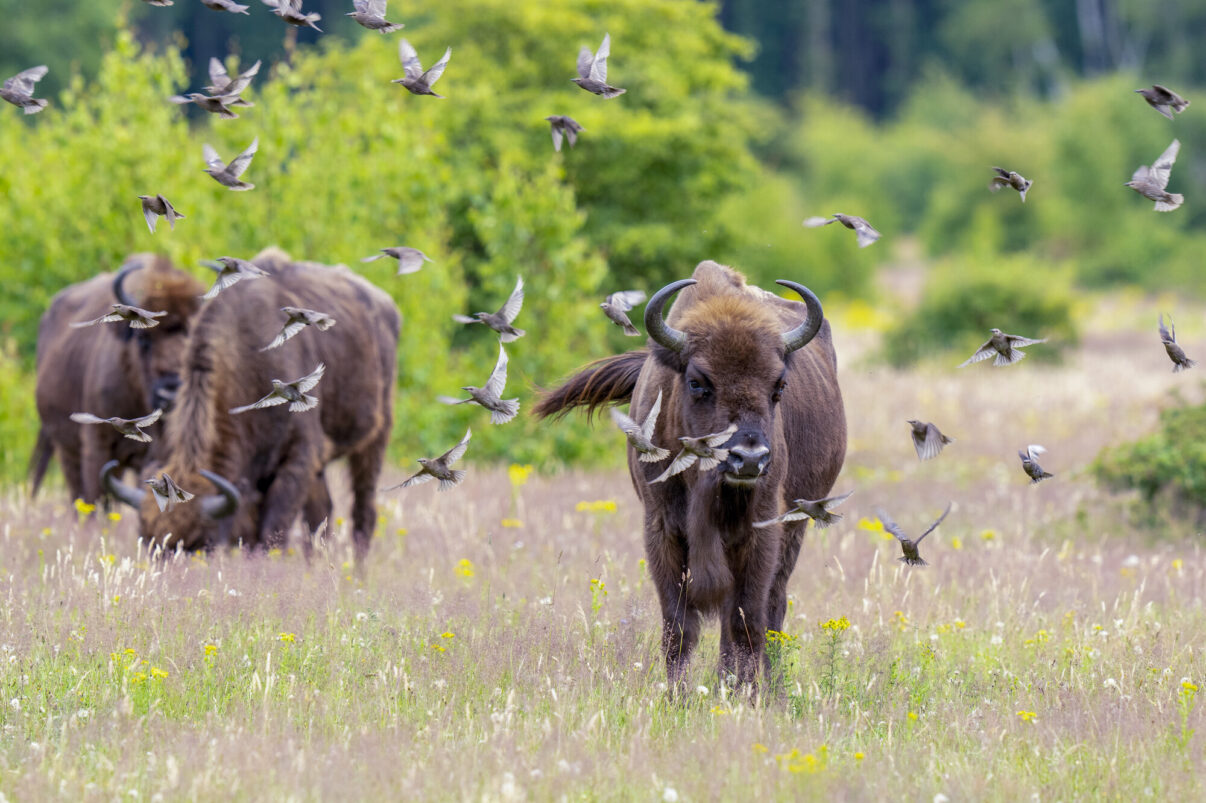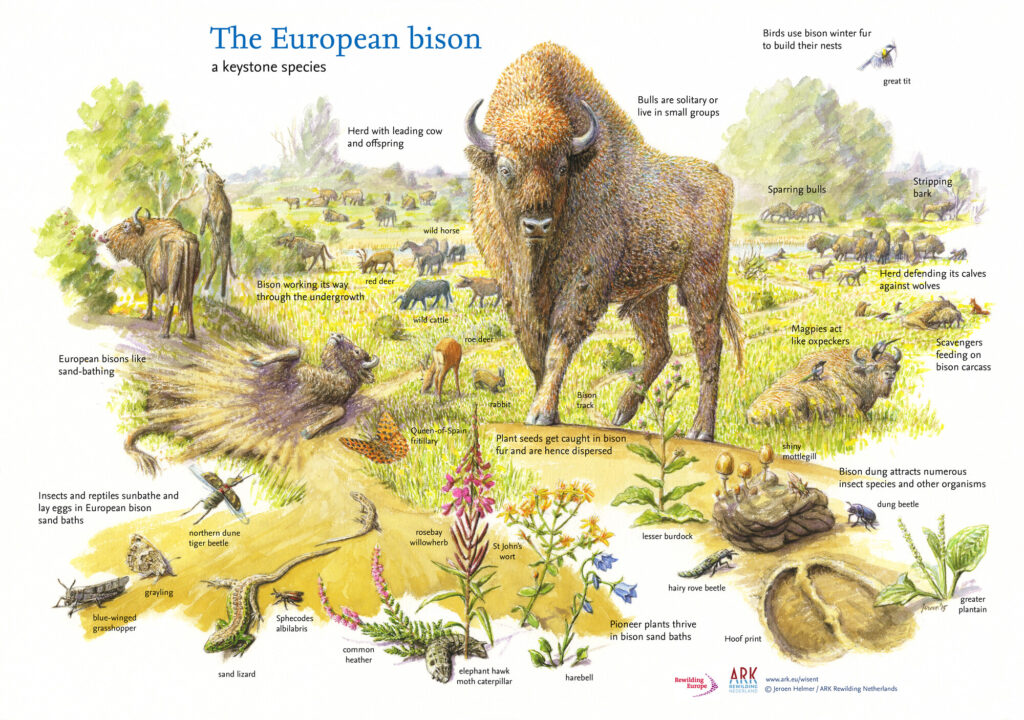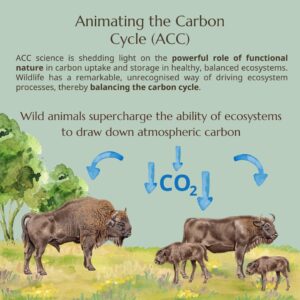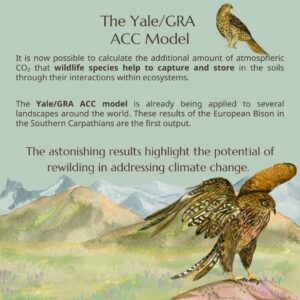The return of the bison in Europe can enhance carbon sequestration, boost biodiversity, and drive the growth of nature-based tourism. To maximise the beneficial impact of this iconic herbivore, populations need to roam freely across large, well-connected landscapes.

Rewilding: a holistic nature-based solution
Biodiversity collapse and climate change are inextricably linked, which means both issues need to be addressed simultaneously. Our future depend on the recovery of the natural world, so that it can adapt to accelerating climate change, and the negative climate impact arising from biodiversity loss can is brought to a halt. Nature’s capacity to reduce the level of greenhouse gases that are already in our atmosphere needs to be maximised as quickly as possible.
By enabling nature to recover – which means restoring the health and functionality of ecosystems such as forests, grasslands, peatlands, and seagrass meadows, and returning wildlife populations to natural levels – rewilding at scale is one of the best ways of addressing climate change and enhancing biodiversity at the same time. As Rewilding Europe’s work in our portfolio of landscapes is demonstrating, the comeback of wildlife and revitalisation of natural processes also have the potential to enrich people’s lives and livelihoods in a sustainable way, which in turn generates more support for rewilding at a grassroots level.

Game-changing impact
As a keystone and flagship rewilding species, the European bison has the potential to be both a climate and biodiversity hero. This is one of the reasons why the ongoing reintroduction of this influential herbivore in European landscapes, coupled with efforts to support population growth, is so important. Through their grazing, foraging, trampling and fertilising, bison help to maintain biodiversity-rich mosaic landscapes of forest, scrub, and grassland, as well as numerous micro-habitats, which host a wide range of plant and animal species. This has been highlighted by studies in Europe, as well as in North America with regard to the related American bison. These same interactions promote the capture of atmospheric carbon in both vegetation and the soil, with carbon also stored in the bodies of the bison themselves.
The positive climate impact of European bison has been underlined in a new modelling study by the Yale School of the Environment, which has yet to be peer-reviewed. The researchers calculated that the European bison population currently roaming free in the Southern Carpathians rewilding landscape in Romania could help grasslands in the area to capture roughly 10 times as much carbon as they were before bison were reintroduced. Following the translocation 99 European bison to the Southern Carpathians by Rewilding Europe and WWF Romania between 2014 and 2023, the current population of bison roaming free in the landscape is estimated at around 180 individuals, with a range in excess of 300 square kilometres. As the population grows, so its range and positive impact will increase, with a herd of bison already crossing into Domogled-Valea Cernei National Park, with which Rewilding Romania has recently signed a partnership agreement.
“We already know that the European bison benefits nature in many ways, while the recovery of bison populations can support the growth of nature-based tourism,” says Rewilding Europe’s Executive Director Frans Schepers. “But the results of this study magnify the importance of bringing back wildlife, including more bison, into European landscapes. Wildlife is the unsung hero in mitigating climate change and rewilding can play a key role supporting wildlife comeback.”

The bigger picture
As a holistic nature-based solution, rewilding is not simply about increasing the population sizes of particular animals. While the European bison continues to be an emblematic species for rewilding efforts in the Southern Carpathians, the overall goal of such efforts is to increase the health and functionality of the entire landscape. Through its integrated landscape approach, which may encompass everything from the regeneration of natural forests and rewetting of peatlands to the recovery of an array of wildlife species, rewilding creates myriad opportunities for enhancing carbon sequestration and boosting biodiversity.
As evidenced by this latest Yale University study, the critical role of wildlife in locking up carbon – which is called “Animating the Carbon Cycle (ACC)” – is being increasingly proven by a growing body of research. To effectively address climate change, this means we not only need to protect and restore habitats such as forests and grasslands, but the animal populations they host as well. Rewilding can deliver this.
The importance of connectivity and coexistence
For the restoration of animal populations to have meaningful climate and biodiversity impact, they need to be carried out a scale and in fully natural conditions. In many European bison reintroduction initiatives, populations are fenced in and receive supplementary feeding in the winter. In order to maximise carbon drawdown and storage, European bison and other so-called “ecosystem engineers” need to be able to roam freely across large, naturally well-connected landscapes, as is the case in the Southern Carpathians.
Today, Europe is witnessing the gradual return of many of its larger, iconic mammals. Over the last decade, the number of European bison has increased from just over 2500 to around 9000 individuals, which represents a remarkable comeback, considering there were less than 60 individuals alive in zoo and private parks in 1927. Other wildlife species, such as deer and their main predator, the grey wolf, are making a comeback of their own accord. Allowing animals such as bison and wolves to roam freely can present challenges, particularly on a continent as densely populated and infrastructure-laden as Europe, where the vast majority of people are unaccustomed to living alongside wildlife.
In the Southern Carpathians, the Rewilding Romania team are working hard to engage local communities – to understand their needs, raise awareness of rewilding, and ensure that the recovery of nature delivers socio-economic benefits to as many people as possible. This, in turn, enhances human-wildlife coexistence, allowing species such as European bison to recolonise the landscape with as little human interference as possible. Through rewilding’s holistic approach, bison can become community heroes too.
Rewilding Europe is also reintroducing European bison in the Rhodope Mountains of Bulgaria and supporting their comeback in the Oder Delta (Germany and Poland).


